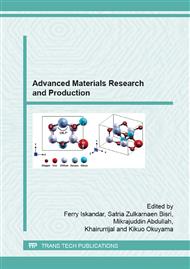[1]
E. Osawa. The Evolution of the Football Structure for the C60 Molecule: A Retrospective. Philosophical Transactions of the Royal Society of London. Series A. 343 (1993) 1-8.
Google Scholar
[2]
S. Iijima, Carbon nanotubes MRS Bulletin, 19, 43-49 (1994).
Google Scholar
[3]
A. Geim and K. Novoselov, A road map for graphene, Nature, 490 (2012) 192.
Google Scholar
[4]
Y. Zhang et al, "Direct observation of a widely tunable bandgapin bilayer graphene, Nature, 459 (7248) (2009) 820–823.
DOI: 10.1038/nature08105
Google Scholar
[5]
S. Banerjee et al, Bilayer pseudospin field-effect transistor (BiSFET): a proposed newlogic device, Electron Device Letters, IEEE, 30(2) (2009) 158–160.
DOI: 10.1109/led.2008.2009362
Google Scholar
[6]
A. Geim and K. Novoselov, The rise of graphene, Nature materials. 6(3) (2007) 183–191.
Google Scholar
[7]
A. S. Aji and Y. Darma, HF Treatment Effect for Carbon Deposition on Silicon (111) by DC Sputtering Technique, The 4th International Conference On Mathematics and Natural Sciences.
DOI: 10.1063/1.4868780
Google Scholar
[8]
H. Alfiadi et al, Time Dependence of Carbon Film Deposition on SnO2/Si using DC Unbalanced Magnetron Sputtering, AIP conference proceeding 1586, 97-100.
DOI: 10.1063/1.4866738
Google Scholar
[9]
A.S. Aji and Y. Darma. Spectroscopy Analysis of Graphene Like Deposition using DC Unbalanced Magnetron Sputtering on γ-Al2O3 Buffer Layer, AIP conference proceeding.
DOI: 10.1063/1.4866758
Google Scholar
[10]
S. Riech and C. Thomsen, Raman spectrocopy of graphite, Phil. Trans. R. Soc. Lond. A. 362, 2271 (2004).
Google Scholar
[11]
Ming Fang et al., Covalent polymer functionalization of Graphene nanosheet and mechanical properties of composites, J. Mater. Chem., Issue 38 (2009).
Google Scholar
[12]
Z. Ni et al., Raman Spectroscopy and Imaging of Graphene, Nano Res, Springer . 273-291(2008).
Google Scholar
[13]
Z. Luo, et al., The origin of sub-bands in the Raman D-band of graphene, Carbon 50 (2012) 4252-4258.
DOI: 10.1016/j.carbon.2012.05.008
Google Scholar
[14]
P. Venezuela et al, Theory of double-resonant Raman spectra in graphene: Intensity and line shape of defect induced and two-phonon bands, Physics Review B84, 035433 (2011).
DOI: 10.1103/physrevb.84.035433
Google Scholar
[15]
A. C. Ferrari et al., Raman Spectrum of Graphene and Graphene Layers, Physical Review Letter 97 (2006) 187401.
Google Scholar
[16]
A.C. Ferrari and D.M. Basko, Raman spectroscopy as a versatile tool for studying the properties of Graphene, Nature Nanotechnology, 8 (2013) 235-246.
DOI: 10.1038/nnano.2013.46
Google Scholar
[17]
A. Ferrari, Raman spectroscopy of graphene and graphene: disorder electron-phonon coupling, doping and nonadiabatic effects, Sol. Tate Comm., 14 (2007) 47.
DOI: 10.1016/j.ssc.2007.03.052
Google Scholar
[18]
C. H Lui and T.F. Heinz, Measurement of layer breathing mode vibrations in few-layer graphene, Phys. Rev. B, 87 (2013) 121404(R).
DOI: 10.1103/physrevb.87.121404
Google Scholar
[19]
S. Kitipornchai, X. He, and K. Liew, Continuum model for the vibration of multilayered Graphene sheets, Phys. Rev. B, 72 (2005) 075443.
DOI: 10.1103/physrevb.72.075443
Google Scholar
[20]
R. Nemanich, First- and second-order Raman scattering from finite-size crystals of graphite, " Phys. Rev. B, 20 (1979) 392.
DOI: 10.1103/physrevb.20.392
Google Scholar
[21]
R. Saito et al, Physical Properties of Carbon Nanotubes, Imperial College Press, ISBN 1-86094-093 (1998).
Google Scholar
[22]
M. Batzill and U. Diebold, The Surface and Material Science of Tin Oxide, Surface Science 79 (2005) 47-154.
DOI: 10.1016/j.progsurf.2005.09.002
Google Scholar
[23]
S. Wang et al, 'Dopants Adsorbed as Single Atoms Prevent Degradation of Catalysts, arXiv: cond-mat/0407260v1.
Google Scholar


